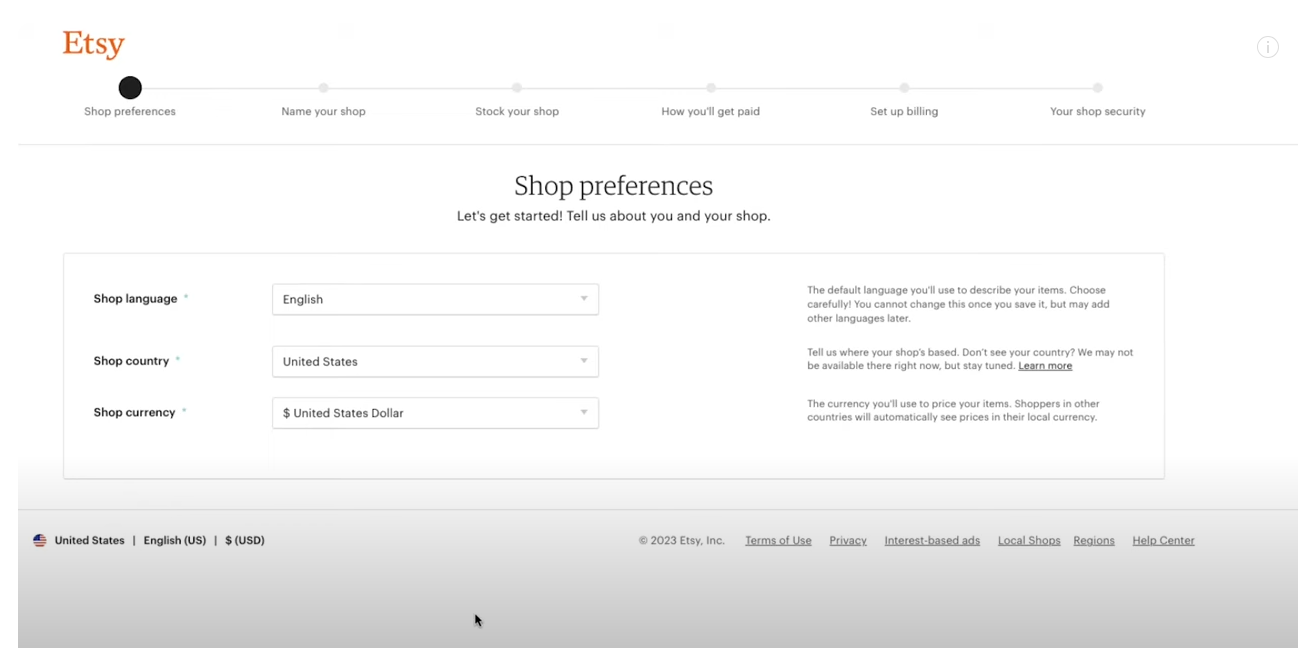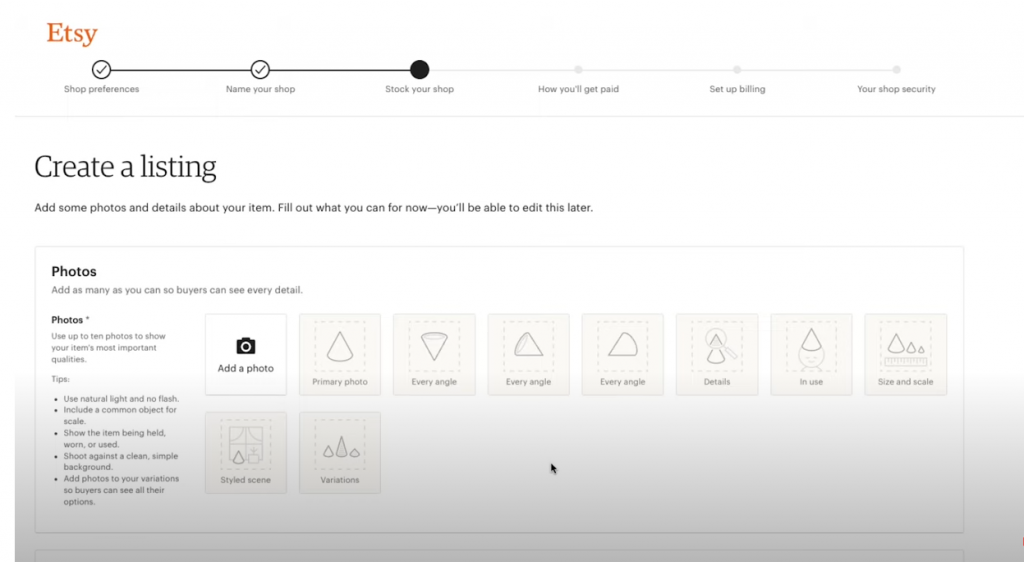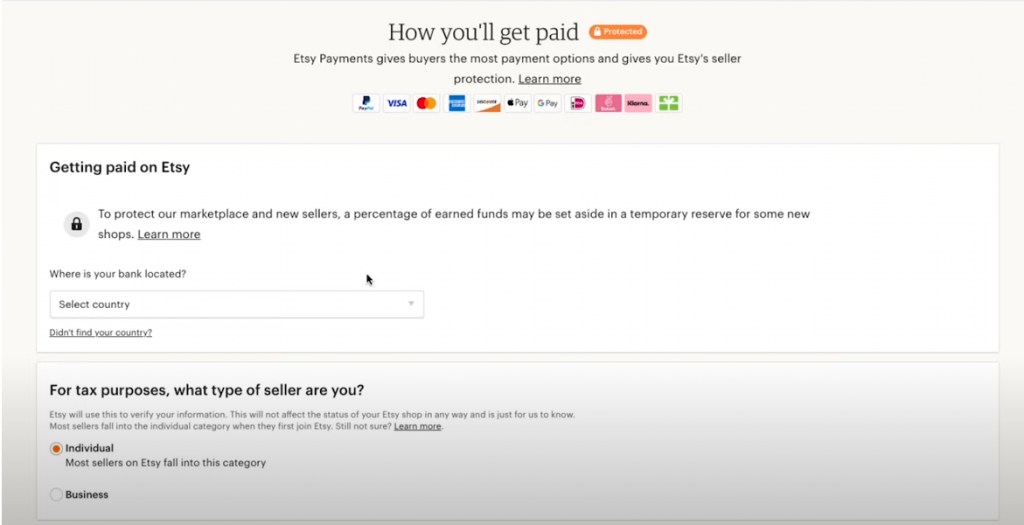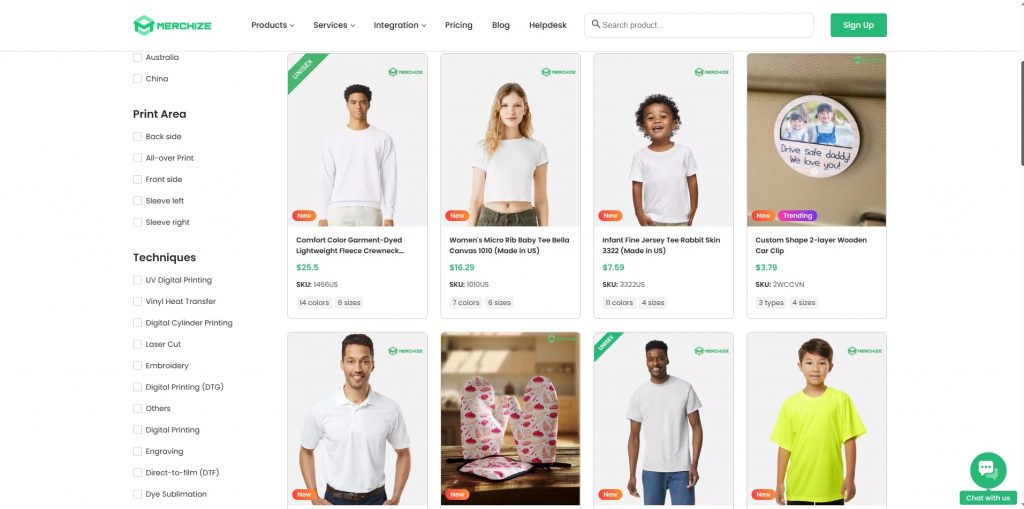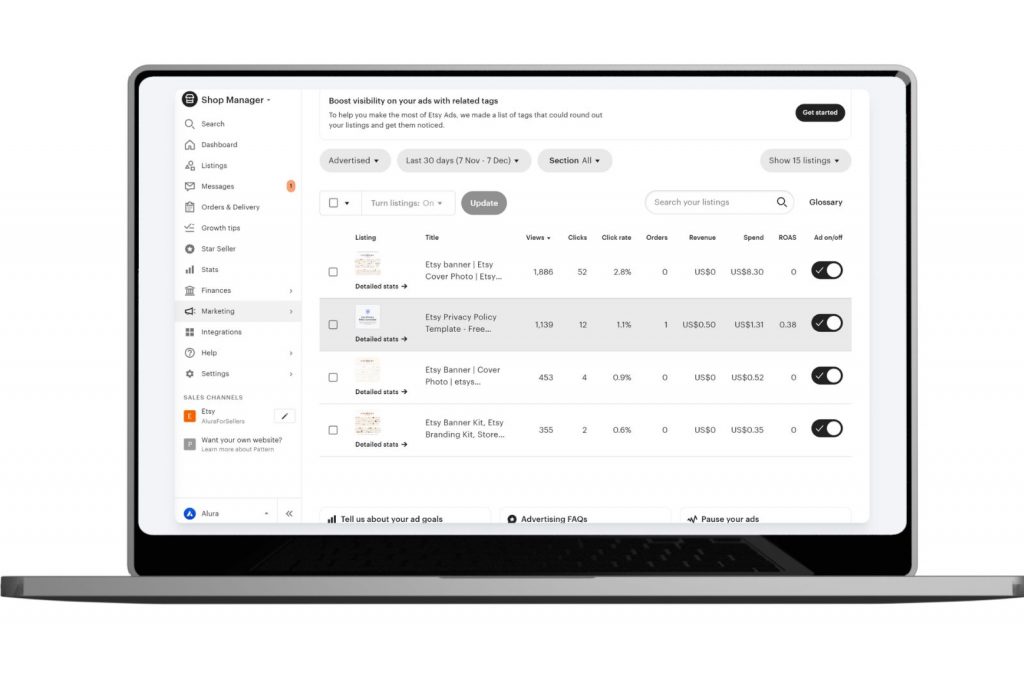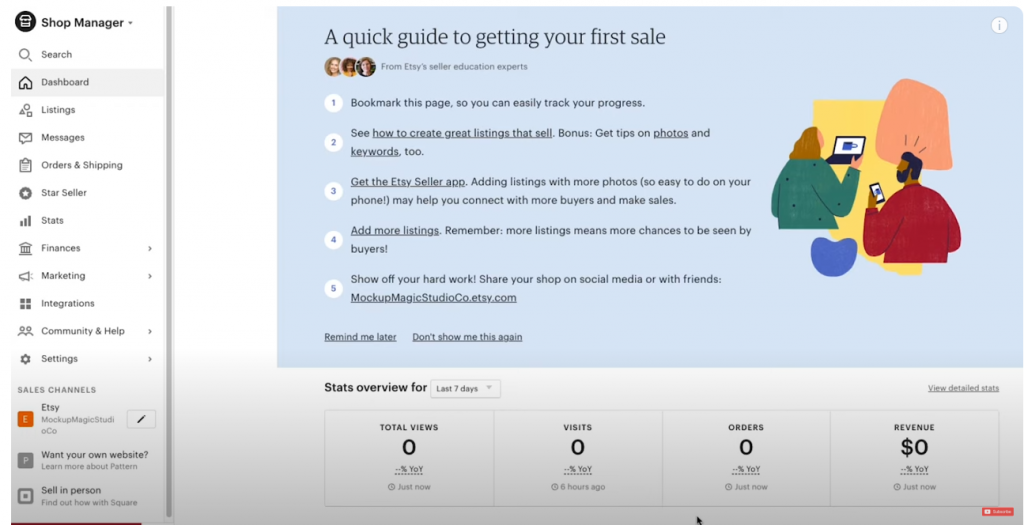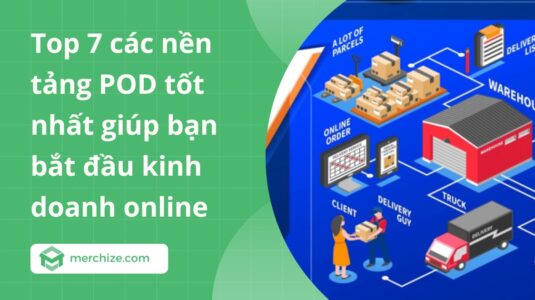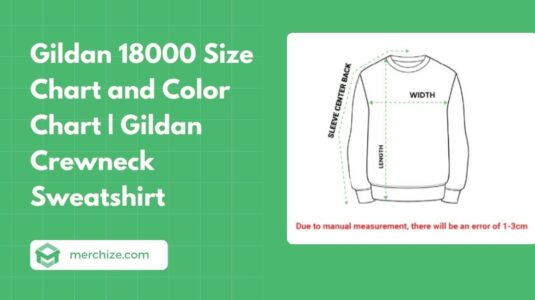Contents
- 1. Find your niche and target audience
- 2. Curate your product offerings
- 3. Craft a winning Etsy business plan
- 4. Set up your Etsy storefront
- 5. Optimize titles, descriptions, and photos
- 6. Establish pricing and shipping strategies
- 7. Boosting visibility with promotion and SEO tactics
- 8. Effectively managing your Etsy shop
- 9. Key tips to remember when selling on Etsy
- 10. Frequently asked questions when running an Etsy store
With over 95 million buyers on the platform, Etsy offers a powerful opportunity for creative entrepreneurs to build an online business. But the truth is, not every store succeeds – especially as more sellers enter saturated markets like t-shirts and mugs.
So how can you be successful on Etsy and have a profitable store?
It starts with understanding how Etsy works, and choosing the right path from the beginning will set you on solid footing. Discover these insights with Merchize in this guide.
1. Find your niche and target audience
Etsy is a vast marketplace, but not everyone can build a successful store on the platform. The key difference between simply making sales and being able to sustain and grow a store lies in choosing the right niche and identifying the target customers.
Each niche represents a specific customer segment with unmet needs that traditional suppliers may have overlooked. By focusing on a niche, you can gain deep market insights, improve your competitiveness, and stay ahead of shifting demand trends.
To choose the right niche for your business, you need to:
-
Research market trends and gaps: Pay attention to customer reviews and feedback that reveal unmet needs on major platforms. These gaps signal potential opportunities for your business.
-
Leverage your passions and expertise: There’s no better way to understand your customers than by drawing from your own experience. This helps you recognize real customer needs that other stores often miss.
-
Define your customer persona: At first, you may only have a general idea of who your customers are. But as your campaigns run, your audience will become clearer in terms of age, gender, and location.
If you’re wondering whether selling on Etsy is truly worth it, you can explore this detailed guide that breaks down the pros and cons of the platform, helping you make an informed decision.
2. Curate your product offerings
The importance of product selection
The products you choose are the essence that determines how much money you can make selling on Etsy. If your store offers a collection of unique, high-quality products that align with the tastes of your target customers, the number of sales you generate will not disappoint you.
To achieve this, understanding market demand and having a keen sense of trends are crucial factors that will help your store stand out among thousands of competitors. Observe and learn from top-performing stores in your niche, but don’t simply replicate them—your brand identity is what keeps customers coming back in the long run.
Brands that maintain consistency in style and customer experience can achieve customer retention rates 20–30% higher than those lacking consistency (Shopify). Therefore, staying updated on market trends and incorporating seasonal fluctuations will allow you to adjust your product catalogue flexibly.
Optimizing product listings for engagement
Personalized products such as engraved keychains, custom mugs, and printed t-shirts are consistently among the bestsellers on Etsy. Recent data from Data Bridge Market Research shows that the global personalized gifts market was valued at $28.19 billion in 2023 and is expected to reach $57.85 billion by 2031, with an annual growth rate of 9.4 percent.
This growth reflects an essential insight. When you take time to understand what customers truly want and deliver products that create an emotional connection, you gain a clear advantage in both revenue and brand loyalty.
Optimize your product listing for better engagement
A diverse product range also helps attract a broader customer base. Stores offering products at different price points can see an average sales increase higher compared to those focusing on a fixed price or a narrow product category, highlighting the advantage of price diversification in attracting customers. For example, if you are a t-shirt designer, consider expanding your product line to include hats, tote bags, and posters—items that can complement each other to form a complete collection.
Enhancing customer experience through organization
A simple way to improve the customer experience in your Etsy store is to organize your product listings into well-defined, easy-to-browse categories. Grouping items by theme, occasion, product type, or price range helps shoppers find what they are looking for without friction. For example, if you offer custom-printed apparel, you can create categories like “Personalized Gifts”, “Seasonal Collections” and “Best Sellers.”
Product selection is more than just choosing what to sell. It lays the groundwork for building a brand that lasts. When your product range aligns with what customers care about and adds meaning to their shopping experience, you build not only trust but also long-term loyalty.
3. Craft a winning Etsy business plan
To make money on Etsy, you need more than great products – you need a plan. A clear business plan gives your shop direction, helps you avoid common mistakes, and sets the foundation for long-term growth.
Start by choosing a strong name for your store. This name will become your brand, so it should be memorable, easy to pronounce, and reflect the personality of your business.
Next, set specific and achievable goals. Instead of aiming for overnight success, break your targets into smaller steps. For example, getting your first 10 orders within two months is a realistic milestone that keeps you focused and motivated.
When your business plan can evolve with real insights, you will have a stronger chance to grow and make money on Etsy.
4. Set up your Etsy storefront
For customers, your storefront is the first thing they see and the impression they associate with your store’s name. This highlights the crucial role of a professional shopfront in influencing their purchasing decisions.
If you can craft a compelling story to connect with customers—rather than just providing the basic required information—your store will become much more appealing to them.
Enhance your storefront for a better shopping experience
Below is the process for customising your new Etsy store that you can apply right away:
Step 1: Create an Etsy account
- Go to Etsy’s website: Open Etsy.com and click Sign in > Register.
- Sign up for an account: Enter your email and password, or sign up quickly using Google, Apple, or Facebook.
- Set up your shop: After logging in, click Sell on Etsy > Open your Etsy shop.
- Shop preferences: Choose your shop’s language (English is recommended), country, and currency.
- Shop Name: Pick a short, memorable, and unique name.
- Complete setup: Double-check your information and click Open Your Shop.
Etsy account creation interface
Etsy Tip: Before signing up, prepare your ID, bank account, and Visa/Mastercard to ensure a smooth registration process.
Step 2: Set up your shop profile
- Complete your shop’s profile:
- Profile Picture & Banner: Upload high-quality images to create a strong first impression.
- Shop Description: Write a short, engaging introduction about your products and business style.
- Set up shop policies:
- Shipping Policy: Define shipping regions, fees, and processing times.
- Return & Exchange Policy: Clearly state conditions and procedures for returns.
- Optimise your shop for SEO:
- Title & Description: Use relevant keywords to improve visibility.
- Tags: Add targeted tags to enhance product discoverability.
Step 3: Create and list products on Etsy
- Access the product management page: In your Etsy Shop Manager, go to “Listings" and click “Add a listing".
- Upload high-quality product images:
- Add up to 10 images showcasing your product from different angles.
- Use bright lighting and clean backgrounds to highlight details.
- Fill in product details:
- Title: Create a clear, keyword-rich title to improve search visibility.
- Description: Provide detailed information about materials, sizes, and unique features.
- Category: Choose the most relevant category to ensure the right customers find your product.
- Set pricing and stock:
- Price: Set a competitive price considering costs and profit margins.
- Quantity: Enter the available stock for the item.
- Shipping options: Select delivery regions, shipping costs, and estimated delivery times.
- Publish the product: After reviewing all details, click “Publish" to list your product on Etsy.
Create a listing on Etsy
Step 4: Set up payment methods
- Access payment settings: In Shop Manager, go to “Finances" > “Payment settings".
- Choose payment methods:
- Etsy supports credit/debit cards, PayPal, Etsy Payments, and more.
- Select the methods that are convenient for both you and your customers.
- Set up a bank account:
- Enter your bank details to receive payments from successful orders.
- Double-check for accuracy to avoid payout delays.
- Verify tax information:
- Etsy may require tax details depending on your country.
- Ensure compliance with local tax regulations.
- Review and save settings: Double-check your information and click “Save" to complete the setup.
Getting paid on Etsy
Step 5: Set up shipping
- Access shipping settings: In Shop Manager, go to “Settings" > “Shipping Settings".
- Create a shipping profile: Click “Add a shipping profile" and name it for easy management.
- Set shipping details:
- Origin zip code: Enter the postal code for your shipping location.
- Processing time: Select how long it takes to prepare and ship an order.
- Shipping destinations: Choose the countries or regions you ship to.
- Shipping services: Select your preferred carriers, estimated delivery times, and costs.
- Set shipping rates:
- Fixed price: Charge a set shipping fee based on the destination.
- Free shipping: Attract more customers by offering free shipping (adjust product pricing accordingly).
- Save and apply shipping profile: Once everything is set, click “Save" to finalise your shipping setup.
Additionally, creating and optimising product listings will increase your visibility to potential buyers, as Etsy’s search algorithm prioritises well-optimised listings. Each product should have a title and description with relevant keywords and clear shipping and return policies.
5. Optimize titles, descriptions, and photos
If your product doesn’t catch attention or show up in search results, it won’t sell—no matter how good it is. That’s why your product title, description, and photos are key to helping customers find and buy from you.
Start with a clear, keyword-friendly title. Avoid vague names like “Cute Bracelet”. Instead, use phrases your customers actually search for, like “Personalised Engraved Silver Bracelet”. This helps your product appear in more searches.
Write a simple but persuasive description. Focus on what the product is, how it’s used, and why it’s valuable. Example:
“The Sebring polo shirt is lightweight and breathable – perfect for work, golf, or everyday wear.”
Use high-quality photos that clearly show your product from different angles. Good lighting and clean backgrounds make your listings look more professional and trustworthy.
Optimize titles, descriptions, and photos for better visibility
Finally, product images are the deciding factor in whether customers click on your listing. Etsy allows up to 10 images per product, and listings with product videos tend to attract more engagement than those with only static images. Capture photos from multiple angles, use natural lighting, or invest in a mini photography lightbox if necessary.
6. Establish pricing and shipping strategies
Pricing and shipping strategies directly impact your store’s profitability and competitiveness on Etsy. Pricing too low may make it difficult to sustain your business long-term, while setting prices too high could drive customers away. That’s why it’s crucial to start by understanding your target customers: How much are they willing to pay for your product? A unique handmade item can be priced higher due to its craftsmanship and exclusivity, whereas a mass-produced product needs a more competitive price.
To set a profitable price, consider production costs, materials, Etsy platform fees, taxes, transaction fees, and shipping expenses. At the same time, researching the pricing strategies of other Etsy stores in your niche can help you adjust your approach effectively. Here are detailed instructions with illustrative examples:
Step 1. Determine production costs and related fees
- Production cost: If you produce a T-shirt, the cost might be $5.
- Listing fee: Etsy charges $0.20 per item listed.
- Transaction fee: Etsy takes 5% of the total sale price, including the product price and shipping fee.
- Payment processing fee: Typically 3% of the sale price + $0.25 per transaction.
Step 2. Calculate the selling price
To ensure profitability while keeping prices reasonable for customers, add up all costs and include your desired profit margin.
Example calculation:
- Production cost: $5
- Listing fee: $0.20
- Transaction fee (5% of $15): $0.75
- Payment processing fee (3% of $15 + $0.25): $0.70
- Total cost: $5 + $0.20 + $0.75 + $0.70 = $6.65
To make a profit, you can set the selling price at $15. After deducting the total costs ($6.65), your profit will be $8.35 per shirt.
A $15 price point is competitive on Etsy and aligns with typical customer spending, ensuring both profitability and market appeal.
Optimising costs will also allow you to set more competitive prices. Etsy offers discounted shipping rates through USPS, FedEx, and DHL, which can help sellers save significantly on shipping fees—take advantage of this. Additionally, if your product can be packaged in a lighter yet secure way, use that to reduce costs further.
Another common strategy is to incorporate shipping fees into the product price and offer free shipping. This can improve your product’s ranking in search results and increase the likelihood of conversions.
7. Boosting visibility with promotion and SEO tactics
If you simply wait for customers to find your store on Etsy, it could take a long time to build a steady customer base. That’s why attracting buyers requires a well-planned strategy. Two ways that can help you do this: if you want to reach customers quickly, you can choose to run ads (cost), and if you have a longer-term plan, use SEO (free).
Leverage Etsy ads to boost visibility
Etsy Ads is one of the most powerful tools Etsy offers, allowing your products to appear at the top of search results and in featured categories. With a pay-per-click (PPC) model, you only pay when someone clicks on your ad, making it an efficient way to control your budget. To get the most out of Etsy Ads, use high-quality images, compelling titles, and clear descriptions highlighting your product’s uniqueness.
- Determine your advertising budget
Start with a small budget to test the effectiveness of your campaign. Etsy Ads follow a pay-per-click (PPC) model, meaning you pay for each click. To estimate efficiency, calculate the average cost per click (CPC) and conversion rate.
Example of an initial advertising budget:
- Test budget: $5/day ($150/month)
- Average CPC: $0.20 – $0.50
- Estimated clicks per day: 25 – 30
- Average conversion rate on Etsy: 1-3%
If we assume a 2% conversion rate, then with 30 clicks/day, you could generate approximately 0.6 orders/day, equalling 18 orders/month from ads.
- Average order value: $25
- Total revenue from ads: $450/month
- Ad cost as a percentage of revenue (ACOS): 33%
A 33% ACOS (advertising cost of sales) may be optimized by adjusting your ad strategy, refining keywords, and targeting the right audience.
- Select the right products to advertise
To maximise ad efficiency, focus your budget on high-performing products that can generate strong revenue. The best products for advertising should meet these criteria:
- Proven sales history or positive reviews.
- High profit margin to cover ad costs.
- Trending or seasonal demand.
Example of product selection:
- Custom-printed T-shirts (production cost: $5, Etsy fees: $2, selling price: $20 → pre-ad profit: $13).
- Personalised tote bags (production cost: $4, Etsy fees: $1.80, selling price: $18 → pre-ad profit: $12.20).
If you spend $5/day on ads and generate 1-2 sales/day, with a $12-$13 profit per item, your post-ad profit would be around $7-$8 per sale. This highlights the importance of selecting high-margin products for ads, as lower-margin items may lead to significantly reduced profits due to advertising costs.
- Monitor & optimize ads
After running a test campaign for 7 to 14 days, you’ll have enough data to analyze whether your Etsy ad strategy is effective. At this point, you should make adjustments based on the results:
- If CPC is too high (above $0.50): Adjust keywords or test a different product.
- If the conversion rate is below 1%, review and improve product images, titles, and descriptions.
- If you identify a high-performing product, increase the ad budget to $10 – $15/day to maximize revenue.
Boost visibility with Etsy ads
However, to maximise results while keeping costs low, start with a small budget, monitor performance, and adjust your campaign based on the results. If you want to reach potential customers quickly, Etsy Ads is a tool you shouldn’t overlook.
Optimize Etsy SEO to increase organic traffic
Like any search engine, Etsy has its own search algorithm, and understanding how it works can help you improve visibility without paying for ads. Customers often search using descriptive phrases like “unique birthday gift” or “custom printed t-shirt” rather than just single words. There are reasons why researching and using the right keywords in your product titles, descriptions, and tags is crucial.
Here are some key steps to optimise your Etsy SEO:
- Keyword Research: Use tools like Etsy’s search bar, eRank, and Marmalead to identify trending search terms.
- Write clear, keyword-rich titles: Make them natural and readable without keyword stuffing.
- Use all 13 tags: Help expand your product’s reach to different searches.
- Optimise customer experience: Etsy favours shops with fast response times, high ratings, and clear shipping policies.
Etsy SEO
Additionally, Etsy gives higher priority to products with reasonable prices, including shipping. If possible, bundle shipping costs into your product price and offer “free shipping” to boost your rankings.
Use social media to expand your reach
Besides running ads and optimising Etsy SEO, promoting your products outside of Etsy can help attract even more customers. Platforms like Pinterest, TikTok, and Facebook Groups are powerful tools for increasing brand awareness and driving traffic to your Etsy store.
8. Effectively managing your Etsy shop
After setting up and starting operations, the next thing you need to focus on is store management. You must monitor performance, optimise processes, and ensure the best shopping experience for customers. This requires perseverance, flexibility, and a clear strategy for sustainable growth.
Etsy provides significant support for sellers by offering the Shop Manager feature, which helps you track views, orders, and revenue, allowing you to make optimal decisions. Additionally, managing your store enables you to keep track of inventory, update products promptly, and process orders efficiently. But please pay attention to Etsy’s policies to avoid errors during the management process.
Shop manager on Etsy
For sellers using the Print-on-Demand (POD) model, such as Merchize, inventory management becomes much simpler, as there is no need to stock large quantities or worry about storage.
The data collected and managed over time will be the key to addressing potential risks that may arise in the future.
9. Key tips to remember when selling on Etsy
One important factor that some sellers tend to overlook is that customer experience is the final step to achieving sustainable growth. Every interaction with a customer is an opportunity to build trust, create a positive impression, and boost sales.
A prompt response to a customer’s initial inquiry can strongly influence their purchasing decision, highlighting the critical role of speed in the overall customer experience. Therefore, how quickly you respond to inquiries, how well you assist customers, and how professionally you handle any issues that arise will significantly impact customer engagement and positive feedback.
Additionally, aim to achieve Etsy’s Star Seller badge, as it helps establish credibility and leaves a strong impression on buyers. To earn this recognition, you need to maintain fast response times, on-time shipping, and consistently positive reviews. Don’t be afraid of negative feedback—see it as an opportunity for improvement. A professional and courteous response can turn an unhappy customer into a loyal supporter.
10. Frequently asked questions when running an Etsy store
Question 1: Common barriers when starting a business on Etsy
High competition: With over 9 million active sellers (Statista), Etsy is a highly competitive marketplace. Popular niches like handmade jewellery or home decor often have hundreds or even thousands of sellers.
Initial costs: While opening a shop only costs $0.20 per listing, expenses such as production, high-quality product photography, and shipping can be discouraging for new sellers. For example, a handmade bracelet seller may need to invest $50–$100 just to create their first batch of products.
SEO and visibility: Etsy functions as an internal search engine. If sellers don’t know how to optimise keywords (titles, tags, and descriptions), their products can easily get “buried" in search results.
Time and management skills: Many sellers underestimate the time required for order fulfillment, customer service, and regularly updating listings. This can lead to difficulties in handling issues when they arise.
Question 2: Taxes
Etsy Fees: Etsy charges a 6.5% transaction fee on each order (including both the product price and shipping fee), plus a $0.20 listing fee per product (renewed every four months). If you use Etsy Payments, there’s an additional payment processing fee (typically 3% + $0.25 in the U.S.).
Income Tax: Earnings from Etsy are taxable in your country of residence. In the U.S., if you make over $400 per year from Etsy, you must report it to the IRS (Internal Revenue Service).
VAT (for international sales): When selling to customers in the EU, Etsy automatically collects VAT (Value Added Tax) from buyers and remits it on your behalf. For example, a $20 order from Germany may include an additional 19% VAT ($3.80), but you don’t have to handle this tax yourself.
Question 3: Which markets on Etsy are the most promising?
USA, UK, Canada: These are the three largest Etsy markets, accounting for over 70% of buyers (according to the Etsy Report). The U.S. stands out with 96 million active buyers who particularly love personalised products such as custom-printed t-shirts or seasonal decor (Christmas, Halloween).
Europe (Germany, France): High demand for sustainable crafts like recycled fabric bags and handmade wooden items. Germany, in particular, is Etsy’s fourth-largest market, driven by the strong “eco-friendly" trend.
Emerging niches: According to an article from Merchize, fast-growing niches with lower competition include pet products (e.g., personalized pet collars), digital downloads (e.g., printable design files), and eco-friendly home goods. These offer great opportunities compared to highly competitive categories like jewellery or clothing.
How to be successful on Etsy? The answer is time, strategy, and dedication—combined with the right approach. Start applying these tips today and take your Etsy business to the next level. Merchize wishes you success on your journey ahead!



